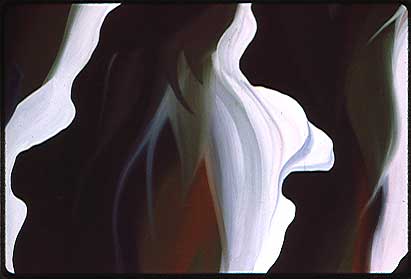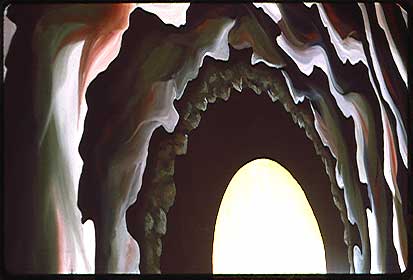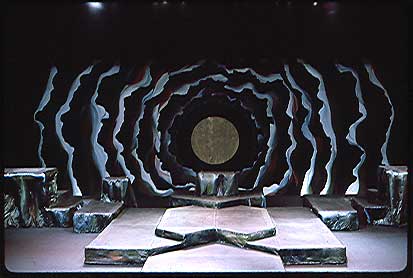|
Creativity
What is atmosphere
or mood?
What is the emotional affect of the product
on the audience? How does it make the audience feel?
In what way
does the product tap into cultural myths, symbols, or archetypes?
How does the
product offer enlightenment or meaning?
How does
the product artistically tie to the rest of the production?
What is the Emotional Affect
of the Product on the Audience? How Does It Make the Audience
Feel?
 To
create atmosphere or mood, the theatrical artist/engineer works
on two levels. The first level is to use elements of a product
to help create an emotional experience. Emotional activity means
that the patron feels something. The second level is to connect
the product to the rest of the production, which creates enlightenment
or meaning. The audience comes to the theatre with expectations
that the theatrical artist uses to help create an emotional response.
The key to creating emotional response is to match adjectives
to an attitude relating to motif. (See The
Unconscious.) To
create atmosphere or mood, the theatrical artist/engineer works
on two levels. The first level is to use elements of a product
to help create an emotional experience. Emotional activity means
that the patron feels something. The second level is to connect
the product to the rest of the production, which creates enlightenment
or meaning. The audience comes to the theatre with expectations
that the theatrical artist uses to help create an emotional response.
The key to creating emotional response is to match adjectives
to an attitude relating to motif. (See The
Unconscious.)
 An
object creates an emotional response by its combination of line,
shape, form, texture, and color as well as the motifs embodied
by that combination. The shape of a skull often represents death
and can create fear. That is, the patron holds a particular attitude
about the shape of a skull. This is not to say that every object
needs to have such a direct representation. Motifs are also actions,
norms, and values. Often, it is the object's combination of line,
shape, form, texture, and color that can create a subtle emotion
as part of the production. An
object creates an emotional response by its combination of line,
shape, form, texture, and color as well as the motifs embodied
by that combination. The shape of a skull often represents death
and can create fear. That is, the patron holds a particular attitude
about the shape of a skull. This is not to say that every object
needs to have such a direct representation. Motifs are also actions,
norms, and values. Often, it is the object's combination of line,
shape, form, texture, and color that can create a subtle emotion
as part of the production.

 This
is a section of a drop, a large, flat, single piece of canvas,
painted for the production of Royal Hunt of the Sun, designed
and painted by Debra Bruch. The brush movement, line, and color
are elements designed to help create a particular emotion, one
of beauty, serenity, and a little bit of chaos. But it does not
end there. This
is a section of a drop, a large, flat, single piece of canvas,
painted for the production of Royal Hunt of the Sun, designed
and painted by Debra Bruch. The brush movement, line, and color
are elements designed to help create a particular emotion, one
of beauty, serenity, and a little bit of chaos. But it does not
end there.

This picture of the same drop shows
the elements in a relationship amongst themselves. Although the
drop is a flat surface (and the camera is at an angle), the elements
create a three-dimensional quality that draws the patron to a
center point. But it does not end there either.

While this picture does not show
the subtlety of color, the whole of the product psychologically
draws the patron into the performance. But the only way this works,
in actuality, is if the audience comes into the theatre with the
attitude that when they are confronted with this drop, the basic
motif of this particular set of painted shapes feels as if it
draws and swallows them into the center. That motif, in this case,
is the archetypal image of a spiral. The feeling, then, is one
of loss of control, or fear. I suppose this is one way to say
it's really the patron's fault!
 Lighting,
sound, and every other engineering product works the same way
according to their own unique set of elements. Lighting,
sound, and every other engineering product works the same way
according to their own unique set of elements.
 The
bottom line, though, is to be an artist when creating something.
Use your own sensitivities and place yourself as an audience member.
Don't think about rules; just do it. The
bottom line, though, is to be an artist when creating something.
Use your own sensitivities and place yourself as an audience member.
Don't think about rules; just do it.
|